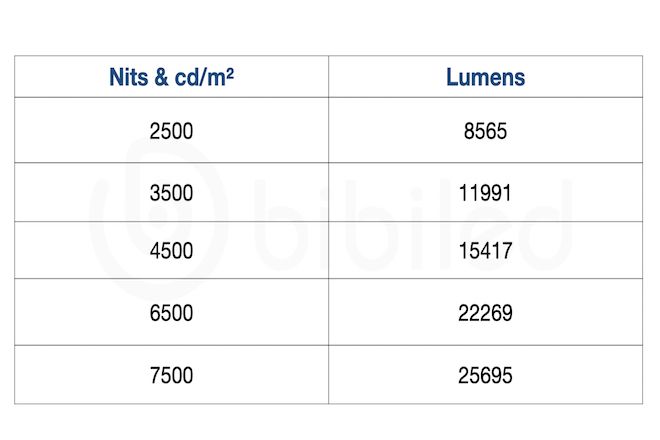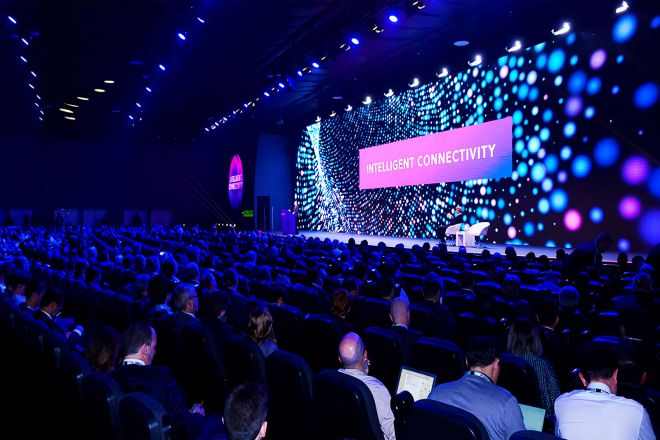序章

Brightness, as one of the core performance indicators of LED displays, is directly related to the visual effects and user experience of the display. An LED表示画面 with appropriate brightness can not only maintain a clear display effect under different ambient lights but also avoid causing visual fatigue or discomfort to the audience.
Therefore, understanding the basic knowledge of LED display brightness is of great significance for the correct use and maintenance of the display, as well as improving its application effect.
This article will take you through the basic knowledge of LED display brightness; let’s take a look.
1. What is NIT?

NIT, as a professional unit of brightness, plays the role of measuring the intensity of light. It not only plays an important role in physics but also occupies an indispensable position in the application of LED displays.
LED display screen, as a representative of modern display technology, its brightness is one of the important indicators for judging its performance. NIT is the specific quantitative embodiment of this indicator.
Through NIT, we can accurately understand the brightness performance of LED displays under different environments and conditions.
In practical applications, the brightness of LED displays needs to be accurately controlled according to the use environment and needs. Too high a brightness may cause eye fatigue, while too low a brightness may not satisfy viewing needs.
Therefore, the introduction of NIT allows us to control the brightness of the LED display more scientifically and accurately, ensuring that it can present the best visual effect in various environments.
In addition, with the continuous development of LED display technology, the requirements for brightness are also getting higher and higher. Whether it is indoors or outdoors, whether it is a static or dynamic picture, the LED display screen needs to have higher brightness to ensure the clarity and layering of the picture.
As a professional unit of brightness, NIT provides an accurate measurement standard for the brightness improvement of LED displays.
2. What is the difference between the brightness and contrast of LED display?
The brightness and contrast of LED displays are two interrelated but significantly different performance indicators.
Brightness mainly measures the intensity of light emitted by the LED display. It represents the luminous intensity per unit area, usually measured in candelas per square meter (cd/m²).
The brightness of the LED display depends on many factors, including the total luminescence of the LED module within the unit volume, the illumination at a certain distance, the number of LEDs and their brightness, etc. In strong light environments, the high-brightness LED display can remain clearly visible, ensuring accurate transmission of information.
The contrast ratio describes the difference in brightness between the brightest and darkest parts of the display. High-contrast LED displays can present richer color levels and clearer details. Contrast is critical to image clarity, color representation, and readability.
The higher the contrast, the clearer the details and contours of the image and the stronger the color reproduction ability. The contrast of the LED display is affected by the brightness, color reproduction ability, and ambient light of the LED lamp beads.
In short, brightness mainly focuses on the overall luminous intensity of the LED display, while contrast focuses on the contrast between different brightness areas on the display. The two jointly affect the visual effects and user experience of the LED display. In actual applications, brightness and contrast need to be balanced and adjusted according to specific needs and usage environments to achieve the best display effect.
3. What are the factors that affect the brightness of LED displays?

The main factors that affect the brightness of LED displays are as follows:
- Quality of LED lamp beads:
LED lamp beads are the basic components of the LED display screen, and their quality directly determines the brightness and uniformity of the screen. If the quality of the LED lamp beads is uneven and there is a large difference in brightness, it is likely to lead to inconsistent screen brightness during use.
In addition, the mixed use of LED lamp beads of different brands or batches may also lead to inconsistent brightness.
- Power supply stability:
The brightness of the display is not only related to the quality of the LED lamp beads but also to the stability of the power supply. The instability of the power supply output current will cause the brightness emitted by the LED lamp beads in different areas to be inconsistent.
Especially when the size of the LED full-color screen is large, long-distance power transmission may cause voltage reduction, further leading to uneven display effects.
- Color calibration:
Color calibration is a key link to ensure the brightness consistency of the LED display. If the color calibration is not accurate, the brightness of the display will also be affected.
- 温度:
Temperature changes are also one of the potential causes of inconsistent brightness of LED displays. The luminous efficiency of LED lamp beads is greatly affected by temperature. When the temperature is too high or too low, the brightness of LED lamp beads may be inconsistent.
- Driving components:
LED full-color display driving components, such as constant current driver chips, also have an impact on the brightness of the display. The performance and setting accuracy of the driving components will affect the brightness difference between the pixels of the LED display.
- Packaging process and materials:
The packaging process and materials of LED lamp beads will also affect their luminous efficiency and brightness. In order to reduce costs during the production process, packaging manufacturers may reduce the size of the light-emitting chip and use a small current drive, which will affect the brightness and service life of the LED display.
4. How does ambient light affect LED display brightness?
The impact of ambient light on the brightness of an LED display is a complex and delicate process involving multiple physical and visual perception factors. Below, we explore in detail how this effect occurs.
First, the brightness level of ambient light directly affects the audience’s perception of the LED display. In bright environments, such as outdoor direct sunlight, the brightness of the ambient light is often much higher than the brightness of the LED display.
If the display isn’t bright enough to compete with ambient light, the content may appear blurry or even completely unreadable. Therefore, in order to meet the viewing requirements in outdoor environments, LED displays usually need to have higher brightness to ensure that their display content is still clearly visible under strong ambient light.
However, in darker environments, such as indoors or at night, the ambient light brightness is low. At this time, if the brightness of the LED display is too high, it may cause visual discomfort or light pollution.
An overly bright display may not only cause eye fatigue but may also affect the viewer’s viewing experience. Therefore, in indoor environments, the brightness of LED displays can usually be adjusted slightly lower to adapt to more stable and lower light conditions.
In addition to the brightness level, changes in ambient light also affect the brightness of the LED display. Throughout the day, the ambient brightness of the outdoor environment changes from soft in the early morning to intense at noon to gradually dimming in the evening.
This large brightness change requires the LED display screen to adjust its brightness accurately in real-time to match changes in ambient light. However, due to the limitations of the physical structure and working principle of LED displays, many products currently on the market cannot fully achieve this. Therefore, in practical applications, it may be necessary to use some advanced technical means, such as ambient light sensing technology, to achieve automatic adjustment of the brightness of the LED display.
Ambient light sensing technology is an optical device that simulates the response mechanism of the human eye to visible light. It is able to detect the current ambient light brightness level in real-time and dynamically adjust the brightness of the LED display based on this information.
In this way, the LED display can maintain the best display effect under different ambient light conditions, neither too bright nor too dark, thus providing a more comfortable and clear viewing experience.
5. Is the higher the brightness of the LED display, the better?

The brightness of the LED display is not better, but it needs to be balanced and selected according to the actual use environment and needs. Here are some considerations regarding LED display brightness:
初めに, high-brightness LED displays do have advantages outdoors or in environments with strong light. In these situations, high brightness can ensure that the display content is clearly visible and is not easily disturbed by ambient light.
For example, outdoor billboards, displays in stadiums, etc., usually require higher brightness to attract the audience’s attention.
しかし, indoors or in low-light environments, excessive brightness may cause visual discomfort or light pollution. Watching a high-brightness display for a long time may cause eye fatigue and even affect vision.
Therefore, when choosing an indoor LED display, appropriate consideration should be given to reducing the brightness to provide a more comfortable viewing experience.
加えて, too much brightness may increase energy consumption and costs. High-brightness LED displays usually require greater power to drive, which not only increases energy consumption but may also increase the cooling requirements and maintenance costs of the equipment.
Therefore, on the premise of meeting usage needs, properly controlling the brightness of LED displays can help reduce energy consumption and costs.
結論
In summary, understanding and mastering the basic knowledge of LED display brightness is of great significance for us to better apply and maintain LED displays and promote the continuous development of its technology.
If you still want to learn more about LED displays, ご連絡ください。
